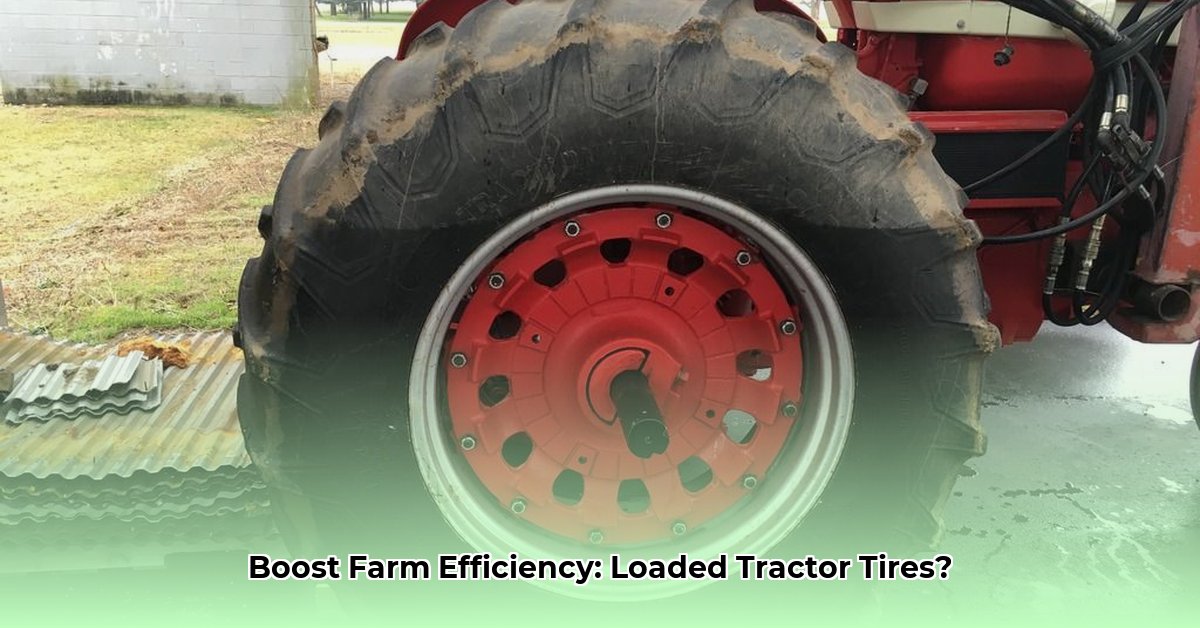
Loaded Tractor Tires: Improving Traction and Efficiency
Adding weight to your tractor tires significantly improves traction and overall farm efficiency. This guide provides actionable advice and technical information to help farmers, dealers, and suppliers make informed decisions about tractor tire weighting. But why bother? Simply put: better traction means faster work completion and reduced fuel consumption. Isn't that something every farmer strives for? For more information on maintaining tire valves, check out this helpful resource: Valve Stem Maintenance.
Why Load Your Tractor Tires?
Heavier tires translate to better grip, especially on challenging terrain like hills or muddy fields. This enhanced traction improves the performance of your tractor's implements, leading to increased productivity and reduced fuel usage. Furthermore, improved stability minimizes the risk of tractor rollovers, enhancing farm safety. Dr. Emily Carter, Agricultural Engineer at Purdue University, notes, "Proper tire weighting is a critical factor in optimizing farm operations and ensuring the safety of farm personnel."
Tractor Tire Weighting Options: A Comparison
Several methods exist for adding weight to tractor tires, each with pros and cons:
1. Fluid Filling: This involves filling tires with liquids like calcium chloride (CaCl2), antifreeze, or beet juice.
- Pros: Cost-effective (depending on the fluid); readily available fluids.
- Cons: Calcium chloride can be corrosive; risk of leaks and messy cleanup.
2. Wheel Weights: These are solid metal weights attached directly to the wheels.
- Pros: Durable, reliable, no leaks or corrosion; environmentally friendly.
- Cons: Higher upfront cost; less flexible weight distribution.
3. Foam Fill: A newer technology that replaces air with foam.
- Pros: Excellent traction and stability; no leaks; minimal maintenance.
- Cons: Most expensive option.
Choosing the Right Fluid: A Detailed Guide
If choosing fluid filling, consider the following:
- Cost: Calcium chloride is cheapest, but corrosive. Beet juice is more expensive but biodegradable.
- Environmental Impact: Beet juice is the most environmentally friendly option.
- Corrosion: Antifreeze is less corrosive than calcium chloride.
- Availability: Consider local availability to minimize costs and delays.
Step-by-Step Guide to Fluid Filling
- Consult your tractor's manual: This is essential for determining recommended fluid type and amount, to maintain warranties.
- Prepare your workspace: Ensure a clean and level area. Gather necessary tools and safety gear (gloves are a must).
- Remove the valve core: Allows for easy fluid insertion.
- Fill the tires: Use a specialized pump for accurate filling.
- Check fluid levels: Follow the manufacturer's recommendations in your manual.
- Replace the valve core: After filling, replace the core securely to prevent leaks.
Risk Assessment Matrix
| Method | Environmental Impact | Corrosion Risk | Leak Risk | Cost |
|---|---|---|---|---|
| Calcium Chloride | High | High | Moderate | Low |
| Antifreeze | Moderate | Low | Moderate | Moderate |
| Beet Juice | Low | None | Moderate | High |
| Wheel Weights | Low | None | Low | High |
| Foam Fill | Low | None | Low | Very High |
Actionable Intelligence: Stakeholder Recommendations
- Farmers: Prioritize safety and long-term cost-effectiveness. Wheel weights, despite higher initial cost, may provide superior long-term value.
- Dealers: Offer a range of weighting options to cater to diverse customer needs and budgets. Provide clear guidance on appropriate fluid choices.
- Suppliers: Promote environmentally friendly options like beet juice. Stock a variety of solutions to address various needs and price points.
Ongoing Maintenance and Considerations
Regularly inspect fluid-filled tires for leaks and corrosion. Consider using protective rim treatments to extend tire life. Wheel weights require less frequent maintenance.
Legal and Environmental Compliance
Always adhere to local and national regulations regarding fluid disposal. Responsible disposal protects the environment.
How to Choose the Best Environmentally Friendly Tractor Tire Ballast Fluid
Choosing a ballast fluid involves balancing cost, climate suitability, and environmental impact. Water is cheap but freezes. Antifreeze works well in cold climates but is toxic. Calcium chloride resists freezing, but it’s corrosive. Beet juice is a biodegradable alternative but is more expensive. The optimal choice depends on your specific farm conditions and priorities.
Ballast Fluid Comparison Table:
| Ballast Type | Pros | Cons | Environmental Impact | Cost |
|---|---|---|---|---|
| Water | Cheap, readily available, non-toxic | Freezes, low density | Low | Very Low |
| Antifreeze (EG/PG) | Effective in cold climates, good density | Toxic, potential environmental hazards | Medium | Moderate |
| Calcium Chloride | High density, resists freezing | Corrosive to equipment, can damage soil/water | Medium | Low to Moderate |
| Beet Juice | Biodegradable, non-toxic, good density | Higher cost, availability may be limited | Low | High |
Choosing the Best Environmentally Friendly Ballast Fluid: A Step-by-Step Guide
- Assess Your Climate: Consider freezing temperatures.
- Consider Your Budget: Beet juice is sustainable but more expensive.
- Evaluate Risk: Weigh the risks of corrosion and toxicity.
- Check Equipment Compatibility: Ensure compatibility with your tractor's tires and rims.
- Plan for Disposal: Consider environmentally friendly disposal methods.
- Research Local Regulations: Understand local and national regulations.
Long-Term Sustainability:
Consider the long-term impact of your choice on your equipment and the environment. Choosing sustainable practices will benefit your farm's future.